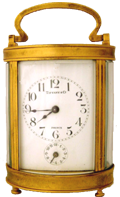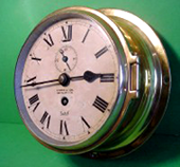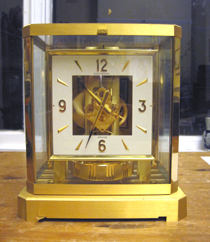
ATMOS CLOCKS
We specialize in the repair of Atmos clocks
-- Clockmaking at its best --
Atmos clocks are made by the renowned swiss company Jaeger LeCoultre.
This is a very fascinating mechanical clock that does not require winding.
Atmos clocks have a "bellow" that expands and contracts
with temperature changes or changes in atmospheric pressure.
These small movements are utilised to keep the mechanism running.
Even though the Atmos is a very fine clock, just like every other clock, it will require servicing . So if your clock is giving trouble, it may not necessarily due to broken or worn parts.
and
Identify your model

MODERN
GRANDFATHER Clocks
from circa 1900 to modern days
There are many variation of the casse design
They usually have a german movement of reasonable quality .. or less common, a high quality american movement.
The modern version of the "grandfather clock" is easily identified by these characteristics:
1) The weights are thin and relatively light, usually 3 of them, encased in brass shells. Antique clocks have one or two weights only.
2) The dial is quite thin and flexible.
3) The pendulum bob, whether large or small, is hollow and light.
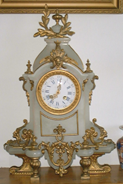 FRENCH CLOCKS
FRENCH CLOCKS
They come in all different cases from marble to wood, from Ormolu
to table regulators etc etc, and can date as far back as the 18th Cent
Follow the link for identification points.
In my modest opinion, they are the best ever made "mass produced" clocks.
Their quality is far superior to many non-mass-produced clocks.
They have lasted for many years and many will be around for many
years to come. For years they have been undervalued due to the
incredible number made by many factories and they are incredible value
for money. Many famous names are associated with french clocks,
and even top clockmaker have not been hesitated to put their names
on these clock, as an assurance of quality,... Brocot, Drucot,
Dent, Mappin & Webb
etc just to name a few.
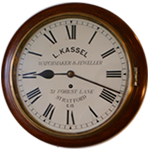 DIAL CLOCKS, WALL CLOCKS
DIAL CLOCKS, WALL CLOCKS
"Fusee" clocks first appeared in the early 1800s and were very popular
throughout this century and the early 1900s. They were everywhere,
private houses, public buildings, train stations, banks, offices etc. They provided work for thousands of people, if
you consider that they all needed weekly winding and regular looking after, to keep them going well
What made them very popular was the english "fusee" design which delivered a very reasonable timekeeping accuracy for all purposes.
Because of its popularity,
American and German cheaper versions were later imported for the British market.
Most dial clocks have pendulums but there are some models with "platforms"
( i.e they have a balance, no pendulum)

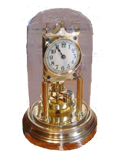 400day CLOCKS... or ANNIVERSARY CLOCKS (Torsion Clocks)
400day CLOCKS... or ANNIVERSARY CLOCKS (Torsion Clocks) 